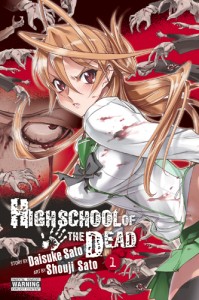If your chief criticism of King of Eden was “not enough boobs,” have I got the manga for you: Zom 100: Bucket List of the Dead, a comedy about a corporate drone whose life is transformed by the onset of a zombie plague. Its hero, Akira Tendo, sees opportunity where others see only chaos, and decides to make a bucket list of 100 things he wants to do before he, too, becomes one of the walking dead. His top priorities? Telling his voluptuous co-worker Ohtori how much he likes her—even if she is the “boss’ side piece”—and tracking down a mysterious hottie he encounters in a convenience store.
While Akira’s quest doesn’t sound particularly memorable, his new-found optimism makes him an agreeable guide through a Tokyo overrun by zombies. His palpable joy in quitting a soul-crushing job is infectious—if you’ll pardon the expression—as he finds pleasure in small things: riding a motorcycle for the first time, scavenging for his favorite beer, playing video games during normal business hours. No matter how much carnage he encounters, or how many of his bucket-list errands don’t go according to plan, Akira’s can-do spirit remains undiminished. So, too, is his loyalty to others, as evidenced by his willingness to rescue his childhood friend Tencho from a hotel overrun by zombies.
The hotel scene is indicative of what’s good and not so good about Zom 100. On the one hand, the friends’ shared ordeal leads to a heartfelt exchange in which they discuss why they drifted apart after college. Their dialogue is a little on-the-nose—“I got jealous of how successful you were and took my anger out on you,” Akira confesses in a torrent of tears and snot—but the characters’ sincerity makes Akira and Tencho’s reconciliation feel like a genuine moment of maturity.
On the other hand, the main reason this scene begins in a hotel—specifically, a love hotel—is to offer some good old-fashioned fan service, as Kencho is trapped in a bondage chamber with an irate, naked zombie who’s been chained to the wall. The zombie is drawn in loving detail, right down to her perky breasts, but serves no real dramatic purpose; she exists mainly to make young male readers gawp at Kencho’s predicament. The same goes for several other gratuitous moments of nudity and pin-up posturing, none of which feel necessary or demonstrate artist Kotaro Takata’s skill at drawing attractive, anatomically correct women. (All of his figures seem to have a few extra vertebrae.)
The fan service is indicative of a deeper problem as well: the zombies—or the boobs, for that matter—don’t feel essential to Akira’s story. Almost any catastrophe or life-altering event could have set the plot in motion, whether it was a devastating medical diagnosis or Earth’s impending collision with a meteor. Equally disappointing is that Akira’s quest feels more like a to-do list than a real emotional journey; even he seems disappointed in his inability to come up with a sufficiently long or imaginative bucket list. As a result, Akira seems like just another standard-issue shonen lead, blessed with an optimism that sometimes makes him seem a little dim, a superhuman ability to escape life-threatening situations, and an uncanny knack for stumbling into situations with hot women. I don’t know about you, but I would have enjoyed this series 100% more if the gender roles had been reversed, if only for the sight of a former office lady cheerfully riding a Harley through a zombie horde on her way to score a few brews.
To read a brief excerpt of Zom 100: Bucket List of the Dead, click here.
ZOM 100: BUCKET LIST OF THE DEAD, VOL. 1 • STORY BY HARO ASO • ART BY KOTARO TAKATA • TRANSLATION BY NOVA SKIPPER • TOUCH-UP ART & LETTERING BY VANESSA SATONE • EDITED BY KARLA CLARK • VIZ MEDIA • RATED: OLDER TEEN (PARTIAL NUDITY, GORE, VIOLENCE) • 159 pp.



 If I’ve learned anything from my limited study of horror films, it’s this: zombies come in two flavors. The first type are slow, shambling, and stupid, posing little threat to the hero until they reach a critical mass — say, enough to surround the pub or shopping mall where the hero has hunkered down to await help. The second type are swift of foot and mind, making them a far greater menace to humanity. Raiders is positively crawling with the second type, giving this preposterous yet entertaining story a jolt of visceral energy. Figuratively and literally.
If I’ve learned anything from my limited study of horror films, it’s this: zombies come in two flavors. The first type are slow, shambling, and stupid, posing little threat to the hero until they reach a critical mass — say, enough to surround the pub or shopping mall where the hero has hunkered down to await help. The second type are swift of foot and mind, making them a far greater menace to humanity. Raiders is positively crawling with the second type, giving this preposterous yet entertaining story a jolt of visceral energy. Figuratively and literally.